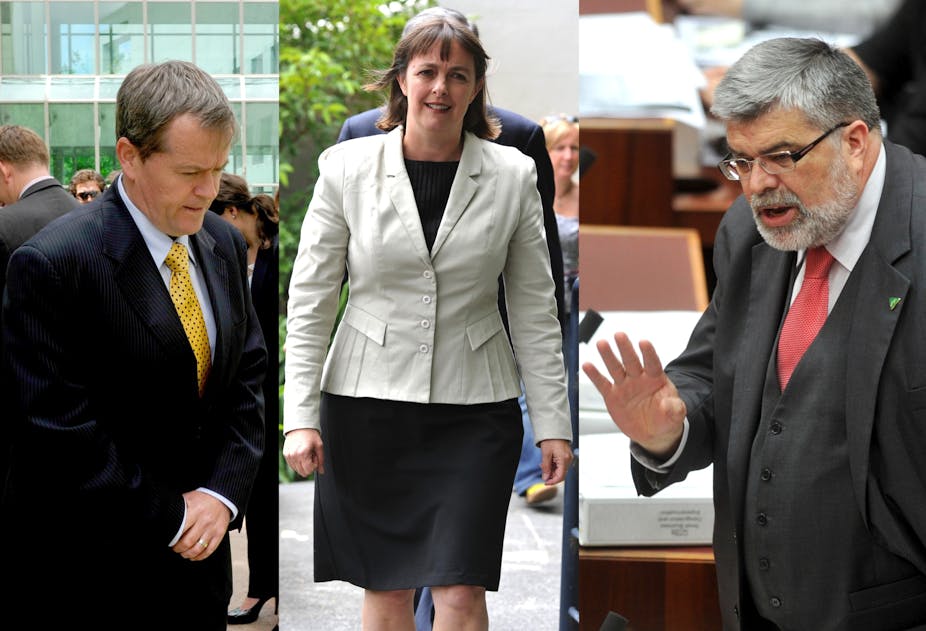In the coverage surrounding Prime Minister Julia Gillard’s cabinet reshuffle yesterday, the media rushed to decide which ministers had won or lost. But the focus on who trumped whom in the political stakes ignored the nature of ALP party politics, and belied a misunderstanding of how ministerial performance is really assessed.
A Labor government will always struggle to reconcile its public message with the inevitability of its factional wrangling. This dilemma has been thrown into the spotlight by both the cabinet shakeup and the recent ALP National Conference.
The ALP National Conference: what the public didn’t see
The most striking thing about attending the ALP National Conference earlier this month was watching the party grapple with itself. Labor struggled to present a strong political face to the public while at the same time managing the internal conflict that inevitably surfaces at an event billed as the party’s supreme decision-making forum.
Electoral considerations, pressure from external groups and sections of the rank-and-file, personal ambitions and factional interests all played out over the three days in two very different forms: what the public was allowed to see and what it was not.
The presentation of policy platform and the mantra of “growth, fairness, jobs” took a prominent place on the public stage. Observers also witnessed a series of lively and passionate debates on contentious policy issues such as the mining tax, gay marriage, asylum seekers and the sale of uranium to India.
What the public did not see was the furious negotiation played out in factional meeting rooms, where the outcomes of the votes on these issues were decided. The final decisions and the policy debates were also shaped by months of drafting, consultation and the creation of a conference agenda.
The end result was a rather disjointed set of proceedings, in which the contentious and often emotive debates did not really reflect the inevitability of the final vote on conference motions and amendments.
The 2011 National Conference once again illustrated what we already know about the ALP: the inevitable domination of the “faceless men” of the Labor factions and the often precarious position of the party leader. But it also revealed some of the more interesting indicators of political success.
Mixed messages
Julia Gillard’s announcement of the changes to her ministry yesterday similarly highlights many of these considerations and expectations, and also the crucial distinction between public and private objectives of political management.
Consistent with the “growth, fairness, jobs” slogan, the very public message the reshuffle is trying to sell is one of a stronger focus on industry, innovation, productivity and participation. Gillard has created a new Department of Industry, Innovation, Science, Research and Tertiary Education, which will be overseen by two Ministers: Greg Combet and Chris Evans. Jenny Macklin has been appointed the new Minister for Disability Reform, charged with overseeing the implementation of Labor’s National Disability Insurance Scheme.
Gillard’s new cabinet also sees a record number of women in senior government positions. In her press conference announcing the changes, Gillard promoted these appointments as a positive step in improving the representation and involvement of women within the ministry.
But the message behind the reshuffle becomes more ambiguous when it begins to intersect with considerations of both electoral accountability and party management. Here the rhetoric of “ministerial performance” is often used to justify the promotion or demotion of individuals to and from particular cabinet positions.
In this round of changes, Kim Carr, Robert McClelland and Peter Garrett were seen as the “losers” or “underperformers”. Carr was moved to the outer ministry, McClelland was demoted from Attorney General and Brendan O’Connor was brought in to assist Garrett with education.
What makes a minister?
While the media are quick to label MPs as either “winners” or “losers” in cabinet reshuffles, what we never see is a considered evaluation of how we gauge good or bad ministerial performance. Accountability for policy decisions and their implementation, relationships with key stakeholders and the public, performance within budgetary constraints, working with colleagues and the management of government departments should be key criteria, but more often than not such decisions are reported in terms of political strategy and shoring up the numbers.
Gillard’s authority as leader has already been questioned due to her decision not to remove Carr and McClelland from the ministry altogether. But apart from any objective consideration of performance on the public side of political debate, what seems to have been forgotten is that the practice of a Labor leader appointing her ministry is a relatively new invention. Factional dynamics have always been used within the party as a mechanism of controlling conflict and distributing positions, previously undertaken by a vote of the parliamentary caucus. This is the private reality of a Labor government.
Contrast the reporting of the reshuffle as a series of backroom deals with a prime ministerial press release that pitches these changes as positive and necessary for the government to focus on its priorities, and there is little wonder the public views party government in Australia with a high degree of scepticism.
Unfortunately, and perhaps inevitably, the strong, coherent policy message the government needs to sell in order to meet social expectations obscures questions of ministerial performance and accountability, which should be much more central to how these matters are reported. The reality is that Gillard must also consider the management of personalities, of legitimate internal political conflict and the institutional and electoral pressures that structure political decision-making in Australian party politics.
What we have instead is a scenario similar to the disjointed outcomes of the Labor conference vote. This is a situation in which the public feels as though it is only seeing, or being told, a very small part of the overall picture – one that will only hinder public debate about party government in Australia.

